Development of Sustainable Home using Net Zero Energy
Develop a report on the development of a sustainable home with net zero energy, comparing it to the current home and analyzing energy and emissions aspects.
34 Pages4131 Words71 Views
Added on 2023-03-17
About This Document
This report explores the technologies and strategies for developing a sustainable home using net zero energy. It discusses the selection of low carbon materials, innovative construction processes, energy management, renewable energy sources, and recycling and reuse. The report also estimates the carbon emissions and costs associated with different materials and provides recommendations for achieving net zero energy homes.
Development of Sustainable Home using Net Zero Energy
Develop a report on the development of a sustainable home with net zero energy, comparing it to the current home and analyzing energy and emissions aspects.
Added on 2023-03-17
ShareRelated Documents
Development of Sustainable Home using Net Zero Energy
DEVELOPMENT OF SUSTAINABLE HOME USING NET ZERO ENERGY
By (Name)
Course
Professor’s name
University name
City, State
Date of submission
1 | P a g e
DEVELOPMENT OF SUSTAINABLE HOME USING NET ZERO ENERGY
By (Name)
Course
Professor’s name
University name
City, State
Date of submission
1 | P a g e

Development of Sustainable Home using Net Zero Energy
Abstract
High energy consumption in the construction industry has warranted efforts to try to achieve
zero carbon emissions in buildings. This report in its various sections goes through the
various technologies that can be applied to achieve zero carbon emission homes. In the
methodology, two different materials, YH and RH, are selected to compare the embodied
carbon energy and the saved costs in both houses. Homer software is used to design on-site
renewable energy supply to achieve net zero emission over the service life of RH. The
simulation results are discussed, challenges explored and recommendations made.
2 | P a g e
Abstract
High energy consumption in the construction industry has warranted efforts to try to achieve
zero carbon emissions in buildings. This report in its various sections goes through the
various technologies that can be applied to achieve zero carbon emission homes. In the
methodology, two different materials, YH and RH, are selected to compare the embodied
carbon energy and the saved costs in both houses. Homer software is used to design on-site
renewable energy supply to achieve net zero emission over the service life of RH. The
simulation results are discussed, challenges explored and recommendations made.
2 | P a g e

Development of Sustainable Home using Net Zero Energy
Table of Contents
Abstract......................................................................................................................................2
Introduction..............................................................................................................................3
2.1 Review low/zero carbon design technology......................................................................4
Selection of low carbon materials...........................................................................................4
Innovative Construction Process............................................................................................4
Management Operative energy consumption and consumption behavior..............................4
Renewable Energy..................................................................................................................4
Recycle and Reuse..................................................................................................................5
2.2 YH Details...........................................................................................................................6
Construction material used in YH..........................................................................................7
Construction Process used in YH...........................................................................................7
Details of heating/cooling, appliances and hot water for YH.................................................8
2.3 RH Details...........................................................................................................................9
Selection of construction materials.........................................................................................9
Selection of manufacturing constituents for RH that need less replacement/maintenance o. 9
Selection of construction process for RH...............................................................................9
The approach to reuse and recycle for RH...........................................................................10
The Energy management design to minimize consumption of energy during heating and
cooling..................................................................................................................................10
The energy management design to minimize the consumption for hot water, and
Appliances............................................................................................................................10
Selection for YH on-site renewable energy..........................................................................11
2.4 Estimating the annual and total carbon emission over the service life of YH and RH
..................................................................................................................................................11
Estimation of embodied carbon emission of YH and RH Construction Material................11
Estimation of carbon emission of YH and RH.....................................................................12
Estimation of carbon emission related to maintenance........................................................13
Estimation of carbon emission from wastes for our RH.......................................................14
Estimation of operating carbon emission with regard to the daily consumption of hot water,
and all appliances of YH and RH.........................................................................................15
Estimation of operating carbon emission in relation to the daily usage for heating and
cooling of YH and RH..........................................................................................................17
Summary of changes with reduction percentage in energy and carbon emissions...............18
2.5 Use HOMER to design on-site renewable energy supply.............................................19
2.6 Estimate cost and benefits off energy saving for RH in comparison with YH...........28
2.7 The feasibility and challenges of implementing RH......................................................28
References................................................................................................................................29
3 | P a g e
Table of Contents
Abstract......................................................................................................................................2
Introduction..............................................................................................................................3
2.1 Review low/zero carbon design technology......................................................................4
Selection of low carbon materials...........................................................................................4
Innovative Construction Process............................................................................................4
Management Operative energy consumption and consumption behavior..............................4
Renewable Energy..................................................................................................................4
Recycle and Reuse..................................................................................................................5
2.2 YH Details...........................................................................................................................6
Construction material used in YH..........................................................................................7
Construction Process used in YH...........................................................................................7
Details of heating/cooling, appliances and hot water for YH.................................................8
2.3 RH Details...........................................................................................................................9
Selection of construction materials.........................................................................................9
Selection of manufacturing constituents for RH that need less replacement/maintenance o. 9
Selection of construction process for RH...............................................................................9
The approach to reuse and recycle for RH...........................................................................10
The Energy management design to minimize consumption of energy during heating and
cooling..................................................................................................................................10
The energy management design to minimize the consumption for hot water, and
Appliances............................................................................................................................10
Selection for YH on-site renewable energy..........................................................................11
2.4 Estimating the annual and total carbon emission over the service life of YH and RH
..................................................................................................................................................11
Estimation of embodied carbon emission of YH and RH Construction Material................11
Estimation of carbon emission of YH and RH.....................................................................12
Estimation of carbon emission related to maintenance........................................................13
Estimation of carbon emission from wastes for our RH.......................................................14
Estimation of operating carbon emission with regard to the daily consumption of hot water,
and all appliances of YH and RH.........................................................................................15
Estimation of operating carbon emission in relation to the daily usage for heating and
cooling of YH and RH..........................................................................................................17
Summary of changes with reduction percentage in energy and carbon emissions...............18
2.5 Use HOMER to design on-site renewable energy supply.............................................19
2.6 Estimate cost and benefits off energy saving for RH in comparison with YH...........28
2.7 The feasibility and challenges of implementing RH......................................................28
References................................................................................................................................29
3 | P a g e
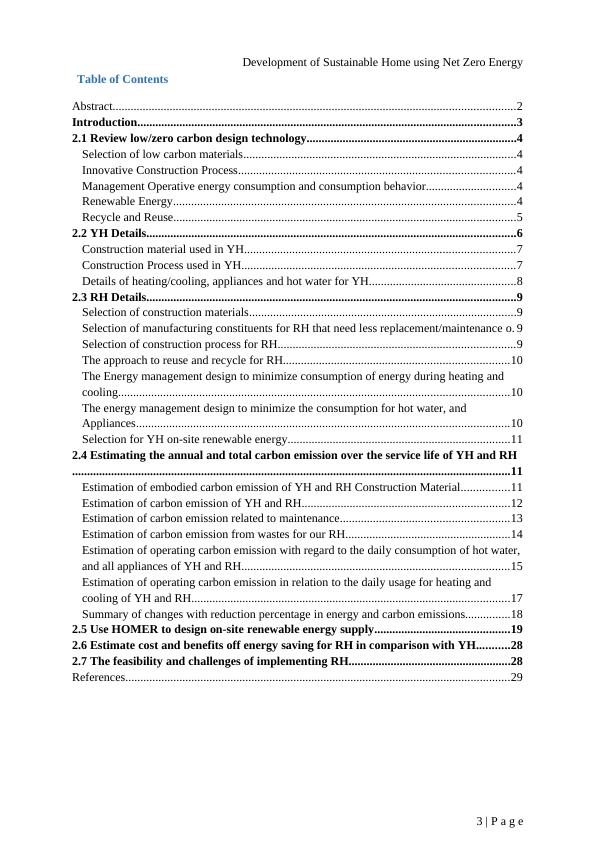
Development of Sustainable Home using Net Zero Energy
Introduction
Energy consumption in the construction industry has been for a long time at a high
percentage of the total energy production on earth. Efforts towards accomplishing net zero
carbon emission buildings have taken over in recent times. Achieving a net zero carbon
emission building requires the annual net energy used by a building to be similar to the
level of renewable energy that the building does produce within its boundaries. This can be
realized by significantly decreasing utility of fossil fuels and minimizing all those
processes that produce greenhouse gases during the construction and maintenance on
buildings. Most zero carbon homes rely on the energy from the national grid, they however
need to return an almost similar amount of power. New buildings can be constructed to be
environmentally friendly and the existing ones retrofitted with technologies that are eco-
friendly, low in cost and energy efficient. This can lower carbon emissions as well as the
energy demands and mitigate overexploitation of natural resources. Greenery systems are
known to be low energy solutions that can be applied in the retrofit of existing buildings.
The other important factor to consider is the right material selection that; allow for low
carbon emission, are modern and more efficient, reduce consumption by using low energy
appliances, supplement power through addition of renewable energy sources and are
recyclable.
The aim of this report is to identify net zero energy solutions for homes by
establishing the various causes of carbon emission. This is done by comparing two
buildings that are different in terms of the selected materials, one referred to as YH and the
other RH. This aids in the calculation of the embodied carbon energy for both houses the
saved costs as a result of the use of renewable energy sources. Possible solutions in the
achievement of net zero energy homes will be recommended in the end. The challenges
encountered during the process shall also be explored.
4 | P a g e
Introduction
Energy consumption in the construction industry has been for a long time at a high
percentage of the total energy production on earth. Efforts towards accomplishing net zero
carbon emission buildings have taken over in recent times. Achieving a net zero carbon
emission building requires the annual net energy used by a building to be similar to the
level of renewable energy that the building does produce within its boundaries. This can be
realized by significantly decreasing utility of fossil fuels and minimizing all those
processes that produce greenhouse gases during the construction and maintenance on
buildings. Most zero carbon homes rely on the energy from the national grid, they however
need to return an almost similar amount of power. New buildings can be constructed to be
environmentally friendly and the existing ones retrofitted with technologies that are eco-
friendly, low in cost and energy efficient. This can lower carbon emissions as well as the
energy demands and mitigate overexploitation of natural resources. Greenery systems are
known to be low energy solutions that can be applied in the retrofit of existing buildings.
The other important factor to consider is the right material selection that; allow for low
carbon emission, are modern and more efficient, reduce consumption by using low energy
appliances, supplement power through addition of renewable energy sources and are
recyclable.
The aim of this report is to identify net zero energy solutions for homes by
establishing the various causes of carbon emission. This is done by comparing two
buildings that are different in terms of the selected materials, one referred to as YH and the
other RH. This aids in the calculation of the embodied carbon energy for both houses the
saved costs as a result of the use of renewable energy sources. Possible solutions in the
achievement of net zero energy homes will be recommended in the end. The challenges
encountered during the process shall also be explored.
4 | P a g e
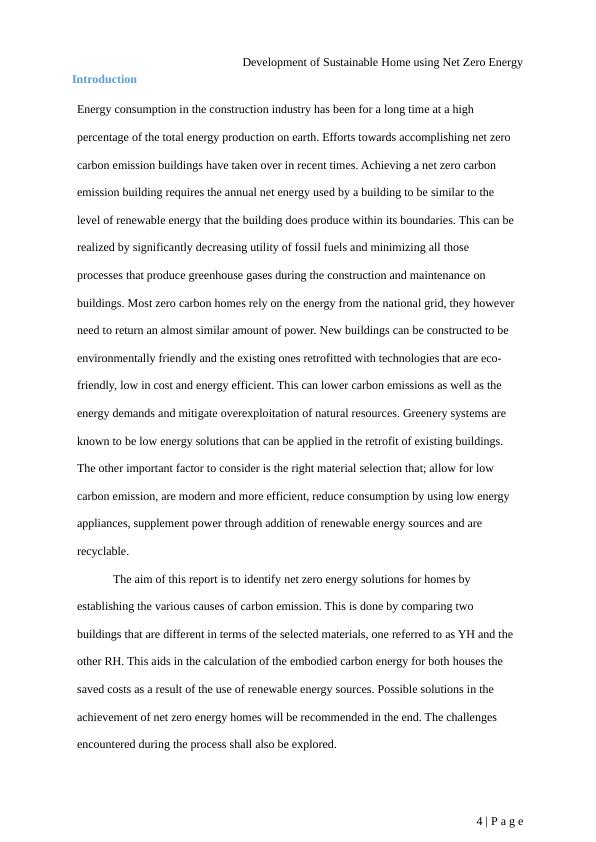
Development of Sustainable Home using Net Zero Energy
2.1 Review low/zero carbon design technology
Selection of low carbon materials
Reducing the embodied carbon for building is a simple practical method that can be
achieved by utilizing by low carbon materials and carbon sink. Low carbon materials can be
obtained from materials that poses low embodied energy and carbon (EEC) during the
production process, assembly and transportation. On the other hand, carbon sink can be
obtained from wood products. The harvested wood materials include cladding and flooring
materials, doors, window frames, furniture, rafters and beams. However, bamboo also
receive great attention and is considered to be tougher than soft steel. The widely used
bamboo product is the treated bamboo flooring. Examples of low carbon building materials
include green concrete, low carbon brick, green tiles, rammed earth walls, fly ash blocks
etc. (Anderson & Shiers, 2009).
Innovative Construction Process
To achieve net zero energy home, various innovation construction strategies must be
implemented in the design. This means various factors need to be considered in the design
such as day lighting by increasing the number of size of the fenestrations while ensuring that
wall to window ration is high, allowing natural ventilation and cross ventilation, envelope
airtightness, radiant cooling and allowing under floor supply of air, and ensuring that the
orientation of the building is facing the direction of wind to allow proper ventilation to
maximize on the quality of pure and clean air (Balzani, 2010).
Management Operative energy consumption and consumption behavior
The consumption of energy in our homes remain crucial factor to be looked into since
buildings have very limited influence on the power consumption in the house. The electrical
consumed in the buildings remain high despite the low occupancy. In order to help minimize
5 | P a g e
2.1 Review low/zero carbon design technology
Selection of low carbon materials
Reducing the embodied carbon for building is a simple practical method that can be
achieved by utilizing by low carbon materials and carbon sink. Low carbon materials can be
obtained from materials that poses low embodied energy and carbon (EEC) during the
production process, assembly and transportation. On the other hand, carbon sink can be
obtained from wood products. The harvested wood materials include cladding and flooring
materials, doors, window frames, furniture, rafters and beams. However, bamboo also
receive great attention and is considered to be tougher than soft steel. The widely used
bamboo product is the treated bamboo flooring. Examples of low carbon building materials
include green concrete, low carbon brick, green tiles, rammed earth walls, fly ash blocks
etc. (Anderson & Shiers, 2009).
Innovative Construction Process
To achieve net zero energy home, various innovation construction strategies must be
implemented in the design. This means various factors need to be considered in the design
such as day lighting by increasing the number of size of the fenestrations while ensuring that
wall to window ration is high, allowing natural ventilation and cross ventilation, envelope
airtightness, radiant cooling and allowing under floor supply of air, and ensuring that the
orientation of the building is facing the direction of wind to allow proper ventilation to
maximize on the quality of pure and clean air (Balzani, 2010).
Management Operative energy consumption and consumption behavior
The consumption of energy in our homes remain crucial factor to be looked into since
buildings have very limited influence on the power consumption in the house. The electrical
consumed in the buildings remain high despite the low occupancy. In order to help minimize
5 | P a g e
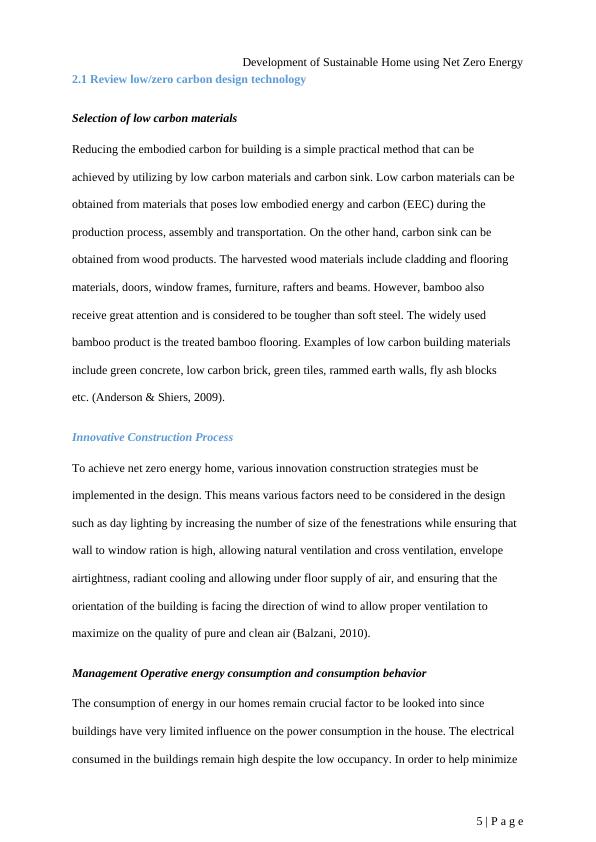
Development of Sustainable Home using Net Zero Energy
the amount of operative energy in our redesigned building, there will be need to use energy
efficient appliances such as the LED lamps is mandatory. The HVAC system should be also
be installed with thermostat to help regulate the indoor temperatures automatically by
switching them on and off automatically when necessary. The occupants should also have a
discipline behavior towards energy consumption by using them sparingly to help achieve low
energy goal as stated in the Kyoto protocol of 1995 and backed up by the United Nation
Framework Convention on Climate Change (UNFCCC).
Renewable Energy
The sources of energy to be tapped for this kind of design to help in achieving low or net zero
energy are the natural sources of energy that can be replenished. These include solar energy
tapped from the sun using photovoltaic system and , wind energy, Renewable energy is
referred to as energy usually tapped from renewable resources, w harnessed from wind
turbines(Bergh, 2008). Another source of energy that has not been fully tapped into is the use
of biomass energy (Goswami, 2006).
Recycle and Reuse
Certain building materials can be easily recycled and reused such as stones, wood, water and
soil. Instead of depositing these wastes on the landfills which increases the emission pf
carbon, they can be recycled and reused for other purposes in the building. The water used in
the building can also be recycled and used for other purposes such as flushing the toilet,
watering plants, washing clothes and machines including other outdoor purposes. Plastic bags
can also be recycled to reduce the amount of solid waste on land (Borenstein, 2008).
6 | P a g e
the amount of operative energy in our redesigned building, there will be need to use energy
efficient appliances such as the LED lamps is mandatory. The HVAC system should be also
be installed with thermostat to help regulate the indoor temperatures automatically by
switching them on and off automatically when necessary. The occupants should also have a
discipline behavior towards energy consumption by using them sparingly to help achieve low
energy goal as stated in the Kyoto protocol of 1995 and backed up by the United Nation
Framework Convention on Climate Change (UNFCCC).
Renewable Energy
The sources of energy to be tapped for this kind of design to help in achieving low or net zero
energy are the natural sources of energy that can be replenished. These include solar energy
tapped from the sun using photovoltaic system and , wind energy, Renewable energy is
referred to as energy usually tapped from renewable resources, w harnessed from wind
turbines(Bergh, 2008). Another source of energy that has not been fully tapped into is the use
of biomass energy (Goswami, 2006).
Recycle and Reuse
Certain building materials can be easily recycled and reused such as stones, wood, water and
soil. Instead of depositing these wastes on the landfills which increases the emission pf
carbon, they can be recycled and reused for other purposes in the building. The water used in
the building can also be recycled and used for other purposes such as flushing the toilet,
watering plants, washing clothes and machines including other outdoor purposes. Plastic bags
can also be recycled to reduce the amount of solid waste on land (Borenstein, 2008).
6 | P a g e
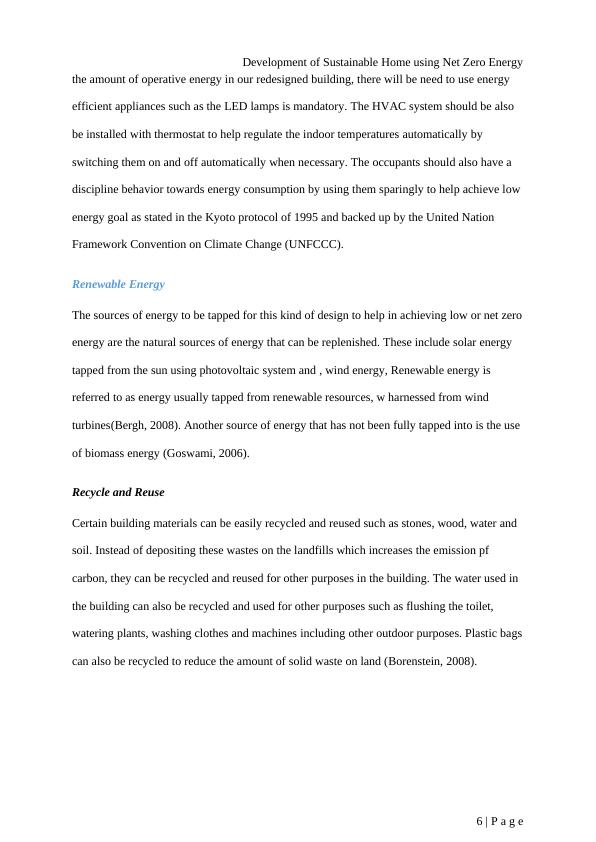
Development of Sustainable Home using Net Zero Energy
2.2 YH Details
Our YH is a 3 bedroom bungalow house located in Hawthorn VC in Melbourne which is
house model 7. The house plan has an area of 182.78m2. Below is the screenshot of the
house plan.
Isometric views from sketchup
7 | P a g e
2.2 YH Details
Our YH is a 3 bedroom bungalow house located in Hawthorn VC in Melbourne which is
house model 7. The house plan has an area of 182.78m2. Below is the screenshot of the
house plan.
Isometric views from sketchup
7 | P a g e
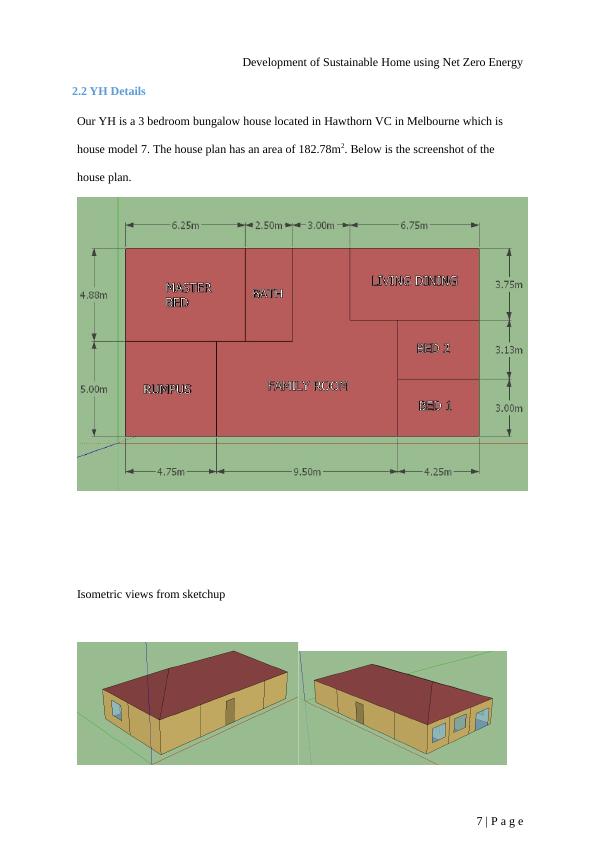
Development of Sustainable Home using Net Zero Energy
8 | P a g e
8 | P a g e
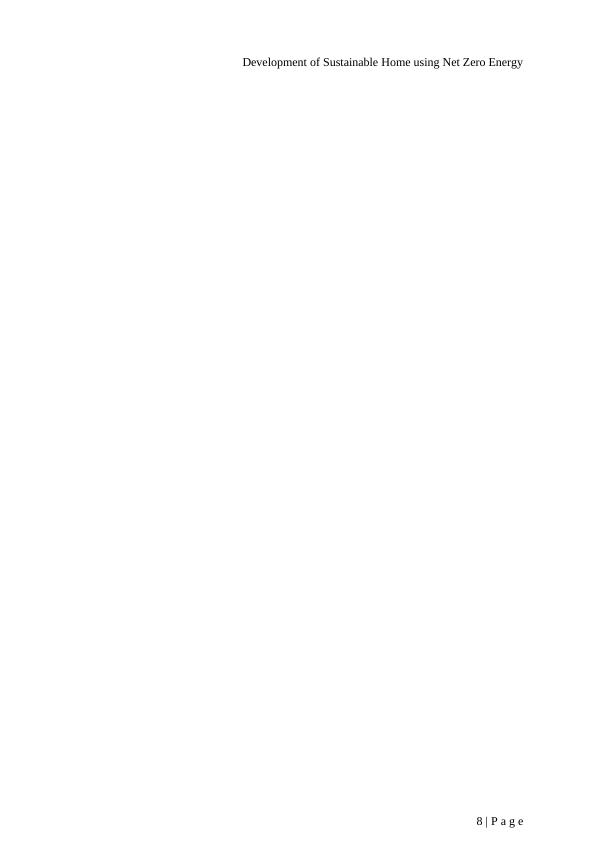
End of preview
Want to access all the pages? Upload your documents or become a member.
Related Documents
Development of Sustainable Home using Net Zero Energylg...
|28
|2719
|339
Development of Sustainable Home using Net Zero Energylg...
|38
|5180
|483
New Methods of Technology for Zero Net Energy Buildingslg...
|70
|14296
|67
Development of Sustainable Home Using Net Zero Energylg...
|42
|7673
|451
Low Carbon Building Design: Approaches, Embodied Energy and Carbon Calculation, and Comparison with Original Modellg...
|17
|1972
|186
Sustainable Homes Assignmentlg...
|9
|1517
|121
